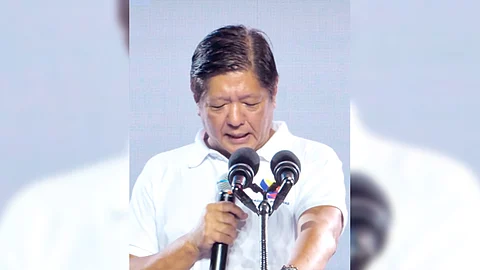
- NEWS
- the EDIT
- COMMENTARY
- BUSINESS
- LIFE
- SHOW
- ACTION
- GLOBAL GOALS
- SNAPS
- DYARYO TIRADA
- MORE

In campaigning for the administration senatorial candidates this week, President Ferdinand Marcos Jr. took a swipe at former President Rodrigo Duterte’s “bloody” approach to combating illegal drugs.
Marcos said his Senate bets are not tainted by the so-called operation “tokhang” of his predecessor, where cops knocked on the doors of homes of suspected drug personalities, often with deadly results.
In pitching for nine PDP Laban candidates at Club Filipino in San Juan City, Duterte once again criticized Marcos over his alleged use of illegal drugs.
“There is a president who is truly high. He is not insane, but drug addiction has long-term effects — Marcos will go crazy. Maybe due to the constant use of heroin, he might reach 80, but by that time, he will no longer be able to move,” Duterte said.
The numbers told the story, albeit with differing perspectives and appreciation in terms of drugs taken off the streets and the consequent number of lives lost in the process.
During the first two years of Duterte’s administration (2016-2018), the authorities reported confiscating 3,294.44 kilograms of shabu and other drugs valued at approximately P25.19 billion.
In contrast, the first two years of the Marcos administration (2022-2024) saw the confiscation of 12,183.65 kilograms of illegal drugs, including 6,481.16 kilograms of shabu, 75.69 kilograms of cocaine, 115,081 ecstasy pills, and 5,626 kilograms of marijuana.
The total value of the confiscations under Marcos reached P49.82 billion, nearly twice that of Duterte’s first two years.
The figures suggest a significant increase in drug seizures under Marcos, attributed to enhanced intelligence operations targeting large-scale trafficking networks rather than street-level dealers.
By the end of 2024, the Philippine National Police (PNP) reported that P20.7 billion worth of illegal drugs were confiscated in that year alone, a 101-percent increase compared to 2023.
Duterte’s war on drugs was characterized by extrajudicial killings and controversial police operations that led to thousands of deaths.
Data from the Philippine Drug Enforcement Agency and PNP indicated that from July 2016 to March 2022, at least 6,241 people were killed in over 233,356 anti-illegal drug operations. Other sources maintained that as many as 20,000 people were killed.
Under Marcos, drug-related deaths were significantly lower, with an estimated 800 drug-related deaths from 2022 to 2024.
PNP chief Francisco Marbil maintained that the Marcos administration’s drive is a “calibrated anti-drug campaign, which puts a premium on human rights.”
Amid the numbers, the public sentiment on the drug war also varied between the two administrations.
Interviews by DAILY TRIBUNE of adults aged 40 to 60 revealed a strong preference for Duterte’s approach, with statements (mostly in the vernacular) like: “Under Duterte, drugs were wiped out. They only came back when he left. The drug syndicates returned.”
Meanwhile, opinions on Marcos’ anti-drug efforts may be summed up by this statement: “Nothing changed; things remained the same. Maybe fewer people have died, but the drugs don’t seem to have decreased.”
“Probably higher [drug prevalence] since drugs are not part of Marcos’ target focus,” another said.
A study by Mendoza, Deinla, Domingo and Yap (2022) on policy satisfaction showed that 71 percent of respondents approved of the government’s (Duterte’s) anti-drug campaign.
Notably, 89.5 percent of Marcos voters supported Duterte’s flagship drug war policy, indicating a desire for continuity in cracking down hard on the drug menace.
Duterte’s administration pursued a three-pronged strategy: Supply reduction, demand reduction, and harm reduction. This led to the dismantling of 1,197 drug dens and 19 clandestine laboratories, the arrest of 15,271 high-value targets, and the rescue of 4,307 minors involved in the drug trade.
Meanwhile, the Marcos administration reported clearing over 27,000 barangays of illegal drugs influence by December 2023, with 23 provinces, 447 municipalities, and 43 cities establishing community-based drug rehabilitation programs.
